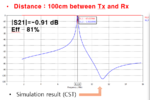nvt088
Member level 4

Hi everyone.
I simulated and fabricated a WPT system using two loops (source and load) and two spiral coils (TX and RX) as showed in picture. The method is resonant coupling.
The simulated result is good. Efficiency at 1m is 80%.
However, my measured result is bad. Efficiency at 1m just 10%. I used Vector Network Analyzer for measurement.
Is there any reason for this low efficiency? Is it exact to use VNA for measuring efficiency because the input power of VNA is very low, 1W, right?
One more question, how to check up the resonant frequency for each loop and spiral coil? I want to make sure they have the same resonant frequency. Many thanks

I simulated and fabricated a WPT system using two loops (source and load) and two spiral coils (TX and RX) as showed in picture. The method is resonant coupling.
The simulated result is good. Efficiency at 1m is 80%.
However, my measured result is bad. Efficiency at 1m just 10%. I used Vector Network Analyzer for measurement.
Is there any reason for this low efficiency? Is it exact to use VNA for measuring efficiency because the input power of VNA is very low, 1W, right?
One more question, how to check up the resonant frequency for each loop and spiral coil? I want to make sure they have the same resonant frequency. Many thanks





